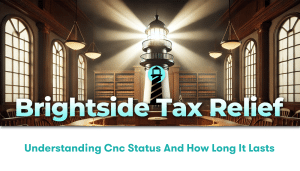Understanding Tax Relief
To comprehend the concept of tax relief, consider it as a reduction of a taxpayer’s obligation to the tax authorities. In the United States, this obligation is primarily towards the Internal Revenue Service (IRS), a government body tasked with the collection and management of taxes. Tax relief can take multiple forms, including deductions, tax credits, or exclusions, and can be applied to various types of taxes – from income tax to property tax. Here is a link to IRS’s resources about tax relief in disaster situations, where tax relief becomes an incredibly important tool.
Brightside Tax Relief LLC’s Role in Tax Relief
Brightside Tax Relief LLC’s central role is to assist taxpayers in navigating the often complex world of tax relief. As a nationwide company, Brightside handles cases across the country, providing professional guidance and expert advice to anyone dealing with tax issues. It’s not just about reducing tax obligations for the current year; it’s also about strategizing for future tax years to maximize tax relief benefits over an extended period.
Forms of Tax Relief
As mentioned earlier, tax relief can come in various forms. Understanding these variants is crucial for efficient tax management. Described below are some of the most common of these types:
Deduction:
A deduction reduces your taxable income, and as a result, decreases your total tax obligation. Deductions might apply for certain expenses you incur throughout the year, specifically if they’re related to the production of income, such as business expenses.
Tax Credit:
A tax credit, unlike a deduction, is a direct reduction of your tax bill. Tax credits typically apply when you contribute towards specific activities encouraged by the government, such as renewable energy production or education.
Exclusion:
Exclusions refer to any income you earn that is not subject to standard taxation. For instance, employer-contributed health insurance benefits are usually considered tax-free income under certain predispositions.
Who is Eligible for Tax Relief?
It’s a false belief that tax relief is only for low-income taxpayers or businesses. Truthfully, various types of tax relief exist for various types of taxpayers – individuals, small businesses, corporations, investment properties owners, etc. With the right planning and advice- both of which Brightside Tax Relief LLC excels at giving, just about any taxpayer can realize some level of tax relief.
How to Apply for Tax Relief
Applying for tax relief typically involves filing a specific form with the IRS or your state-based tax authority. The form required varies based on the type of tax relief being sought. Some of these forms can be complicated and lengthy, causing taxpayers to miss out on significant tax savings due to a simple lack of understanding. However, with Brightside Tax Relief LLC’s expertise, you can make sure you’re not missing those opportunities.
The Consequence of Misunderstanding Tax Relief
The most direct consequence of misunderstanding tax relief is a missed opportunity for savings. However, worse than that, misunderstanding tax laws can lead to blunders on your tax return, potentially leading to an audit, fines, or legal action. Keeping this in mind, it becomes clear how essential expert advice from firms like Brightside Tax Relief LLC can be.
Increase Your Understanding with Brightside Tax Relief LLC
Understanding tax relief might seem daunting, but it does not have to be. Companies like Brightside Tax Relief LLC exist to increase comprehension and potentially save taxpayers a significant amount of money. Equipped with seasoned experts who are well versed in all aspects of U.S. tax laws, Brightside is ready to take the burden of understanding and applying for tax relief off your shoulders.
Final Word
Deciphering the complex world of tax relief requires keen attention to detail and vast tax knowledge. Choosing to partner with a dependable and reputable tax service provider such as Brightside Tax Relief LLC is a strategic move towards proper tax planning and management. It can be the difference between maximizing your saving potential and foregoing considerable financial benefits.




